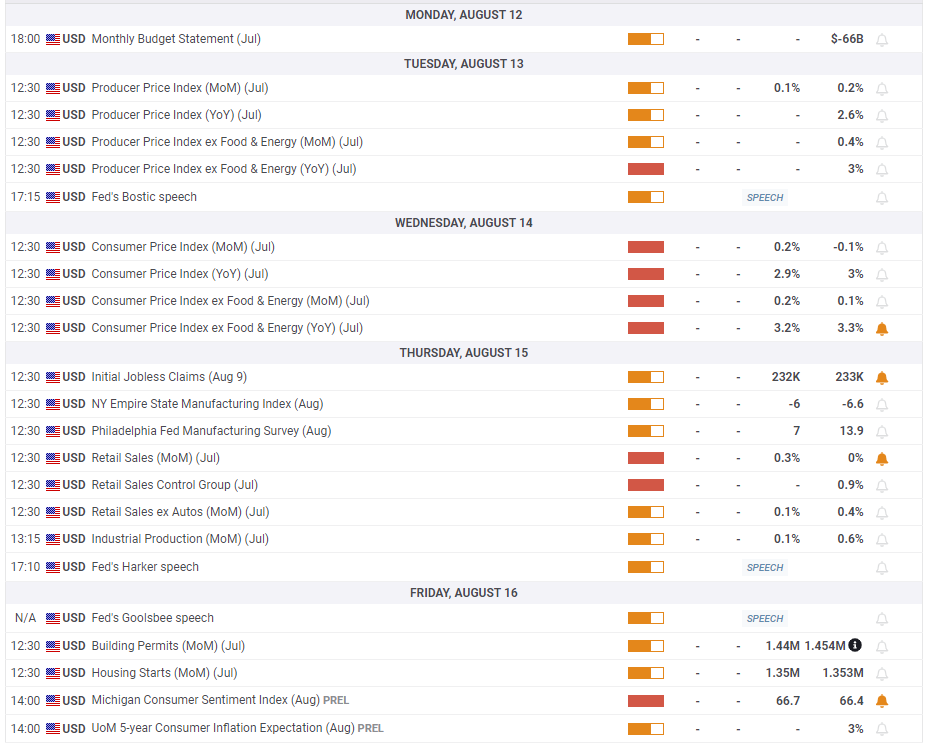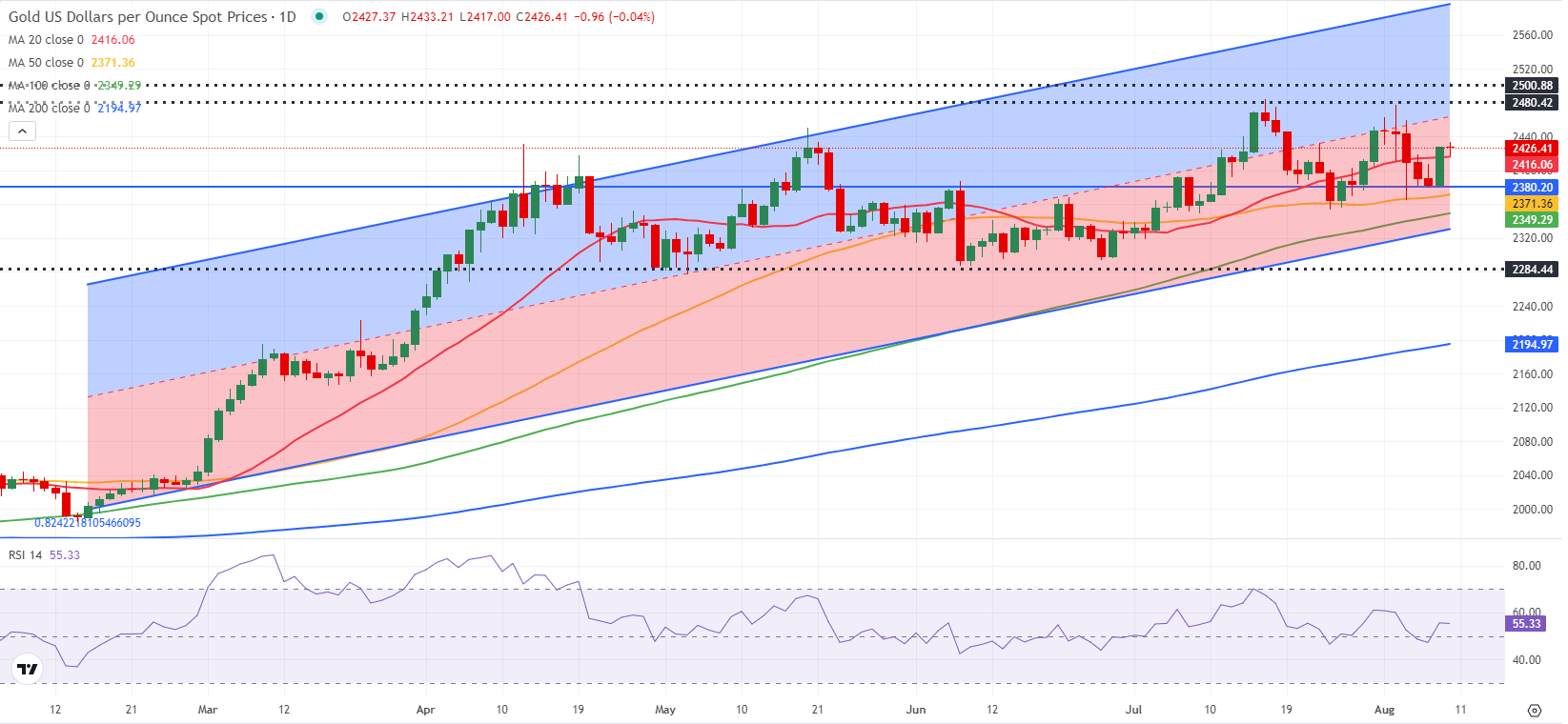- Gold staged a decisive rebound following the bearish action seen in the first half of the week.
- XAU/USD technical outlook suggests that the bullish bias remains intact.
- Investors await US inflation data while keeping an eye on geopolitics.
Gold (XAU/USD) suffered heavy losses at the beginning of the week as a combination of factors triggered a broad market selloff. The metal, however, recovered sharply in the second half of the week and stabilized comfortably above $2,400. Market participants await July inflation data from the US for the next directional clue.
Gold fluctuates wildly as investors adapt to a changing market environment
Gold failed to benefit from escalating geopolitical tensions at the beginning of the week and declined sharply. The unwinding of Japanese Yen (JPY) carry trade, growing fears over a recession in the US and heightened concerns about a deepening conflict in the Middle East triggered a global market selloff on Monday, causing a variety of financial assets, except for the JPY, to suffer heavy losses.
After losing more than 1% on Monday, Gold struggled to find a foothold on Tuesday. Although many assets retraced a portion of Monday’s decline, XAU/USD continued to push lower as the benchmark 10-year US Treasury bond yield staged a decisive rebound, rising nearly 3% on a daily basis.
Gold managed to limit its losses on Wednesday but investors’ focus shifted to risk-sensitive assets on easing concerns over a continuation of the unwinding of the JPY carry trade. Bank of Japan (BoJ) Deputy Governor Shinichi Uchida noted that they will refrain from hiking the policy rate when markets are unstable, noting they must maintain the current degree of monetary easing for the time being.
In the absence of high-impact data releases and fresh geopolitical developments, XAU/USD attracted technical buyers after rising above $2,400 early Thursday and continued to stretch higher on Friday.
Gold investors could take large positions based on US inflation data
Next week’s economic calendar will feature July inflation data from the US. The Consumer Price Index (CPI) is forecast to rise 0.2% on a monthly basis and the core CPI, which excludes volatile food and energy prices, is also seen increasing 0.2% in the same period. On a yearly basis, the headline CPI inflation is forecast to edge lower to 2.9% from 3% in June.
The CME FedWatch Tool shows that markets are pricing in a more-than-50% probability of a 50 basis points (bps) Federal Reserve (Fed) rate cut in September. In case the monthly core CPI rises more than forecast, investors could reassess the probability of a 50 bps cut in September and help the USD gather strength with the immediate reaction. On the flip side, a reading at or below the market expectation in this data could weigh on the USD, opening the door for another leg higher in XAU/USD.
On Thursday, the US Census Bureau will publish the monthly Retail Sales data for July. After remaining unchanged in June, Retail Sales are forecast to rise 0.3% on a monthly basis. Although this data is usually ignored by investors, a significant diversion from the market consensus could impact the USD’s valuation in the near term. A noticeable increase could ease concerns over a recession in the US and weigh on XAU/USD by supporting the USD, while a negative print could have the opposite effect.
In the meantime, market participants will continue to pay close attention to headlines surrounding the Iran-Israel conflict. Generally, Gold becomes one of the go-to assets when geopolitical tensions escalate. This past week’s action, however, showed that other factors have been causing traditional inter-market correlations to weaken. Hence, it might be risky to bet on a Gold rally even if next week’s developments point to a deepening crisis in the Middle East.
Gold technical outlook
After briefly falling below 50 on Tuesday, the Relative Strength Index (RSI) indicator on the XAU/USD daily chart rose toward 60 in the second half of the week, reflecting sellers’ hesitancy. On the upside, $2,470-$2,480 (mid-point of the ascending regression channel coming from mid-February, static level) aligns as the first resistance area before $2,500 (psychological level). In case Gold stabilizes above $2,500 and confirms that level as support, the upper limit of the ascending regression channel coming from mid-February could be seen as the next bullish target at around $2,580.
On the downside, immediate support is located at $2,410-$2,400 (20-day Simple Moving Average (SMA), psychological level) before $2,370 (50-day SMA) and $2,350 (100-day SMA).
Gold FAQs
Gold has played a key role in human’s history as it has been widely used as a store of value and medium of exchange. Currently, apart from its shine and usage for jewelry, the precious metal is widely seen as a safe-haven asset, meaning that it is considered a good investment during turbulent times. Gold is also widely seen as a hedge against inflation and against depreciating currencies as it doesn’t rely on any specific issuer or government.
Central banks are the biggest Gold holders. In their aim to support their currencies in turbulent times, central banks tend to diversify their reserves and buy Gold to improve the perceived strength of the economy and the currency. High Gold reserves can be a source of trust for a country’s solvency. Central banks added 1,136 tonnes of Gold worth around $70 billion to their reserves in 2022, according to data from the World Gold Council. This is the highest yearly purchase since records began. Central banks from emerging economies such as China, India and Turkey are quickly increasing their Gold reserves.
Gold has an inverse correlation with the US Dollar and US Treasuries, which are both major reserve and safe-haven assets. When the Dollar depreciates, Gold tends to rise, enabling investors and central banks to diversify their assets in turbulent times. Gold is also inversely correlated with risk assets. A rally in the stock market tends to weaken Gold price, while sell-offs in riskier markets tend to favor the precious metal.
The price can move due to a wide range of factors. Geopolitical instability or fears of a deep recession can quickly make Gold price escalate due to its safe-haven status. As a yield-less asset, Gold tends to rise with lower interest rates, while higher cost of money usually weighs down on the yellow metal. Still, most moves depend on how the US Dollar (USD) behaves as the asset is priced in dollars (XAU/USD). A strong Dollar tends to keep the price of Gold controlled, whereas a weaker Dollar is likely to push Gold prices up.
Information on these pages contains forward-looking statements that involve risks and uncertainties. Markets and instruments profiled on this page are for informational purposes only and should not in any way come across as a recommendation to buy or sell in these assets. You should do your own thorough research before making any investment decisions. FXStreet does not in any way guarantee that this information is free from mistakes, errors, or material misstatements. It also does not guarantee that this information is of a timely nature. Investing in Open Markets involves a great deal of risk, including the loss of all or a portion of your investment, as well as emotional distress. All risks, losses and costs associated with investing, including total loss of principal, are your responsibility. The views and opinions expressed in this article are those of the authors and do not necessarily reflect the official policy or position of FXStreet nor its advertisers. The author will not be held responsible for information that is found at the end of links posted on this page.
If not otherwise explicitly mentioned in the body of the article, at the time of writing, the author has no position in any stock mentioned in this article and no business relationship with any company mentioned. The author has not received compensation for writing this article, other than from FXStreet.
FXStreet and the author do not provide personalized recommendations. The author makes no representations as to the accuracy, completeness, or suitability of this information. FXStreet and the author will not be liable for any errors, omissions or any losses, injuries or damages arising from this information and its display or use. Errors and omissions excepted.
The author and FXStreet are not registered investment advisors and nothing in this article is intended to be investment advice.
Recommended Content
Editors’ Picks

EUR/USD stays near 1.0400 in thin holiday trading
EUR/USD trades with mild losses near 1.0400 on Tuesday. The expectation that the US Federal Reserve will deliver fewer rate cuts in 2025 provides some support for the US Dollar. Trading volumes are likely to remain low heading into the Christmas break.

GBP/USD struggles to find direction, holds steady near 1.2550
GBP/USD consolidates in a range at around 1.2550 on Tuesday after closing in negative territory on Monday. The US Dollar preserves its strength and makes it difficult for the pair to gain traction as trading conditions thin out on Christmas Eve.

Gold holds above $2,600, bulls non-committed on hawkish Fed outlook
Gold trades in a narrow channel above $2,600 on Tuesday, albeit lacking strong follow-through buying. Geopolitical tensions and trade war fears lend support to the safe-haven XAU/USD, while the Fed’s hawkish shift acts as a tailwind for the USD and caps the precious metal.

IRS says crypto staking should be taxed in response to lawsuit
In a filing on Monday, the US International Revenue Service stated that the rewards gotten from staking cryptocurrencies should be taxed, responding to a lawsuit from couple Joshua and Jessica Jarrett.

2025 outlook: What is next for developed economies and currencies?
As the door closes in 2024, and while the year feels like it has passed in the blink of an eye, a lot has happened. If I had to summarise it all in four words, it would be: ‘a year of surprises’.

Best Forex Brokers with Low Spreads
VERIFIED Low spreads are crucial for reducing trading costs. Explore top Forex brokers offering competitive spreads and high leverage. Compare options for EUR/USD, GBP/USD, USD/JPY, and Gold.

